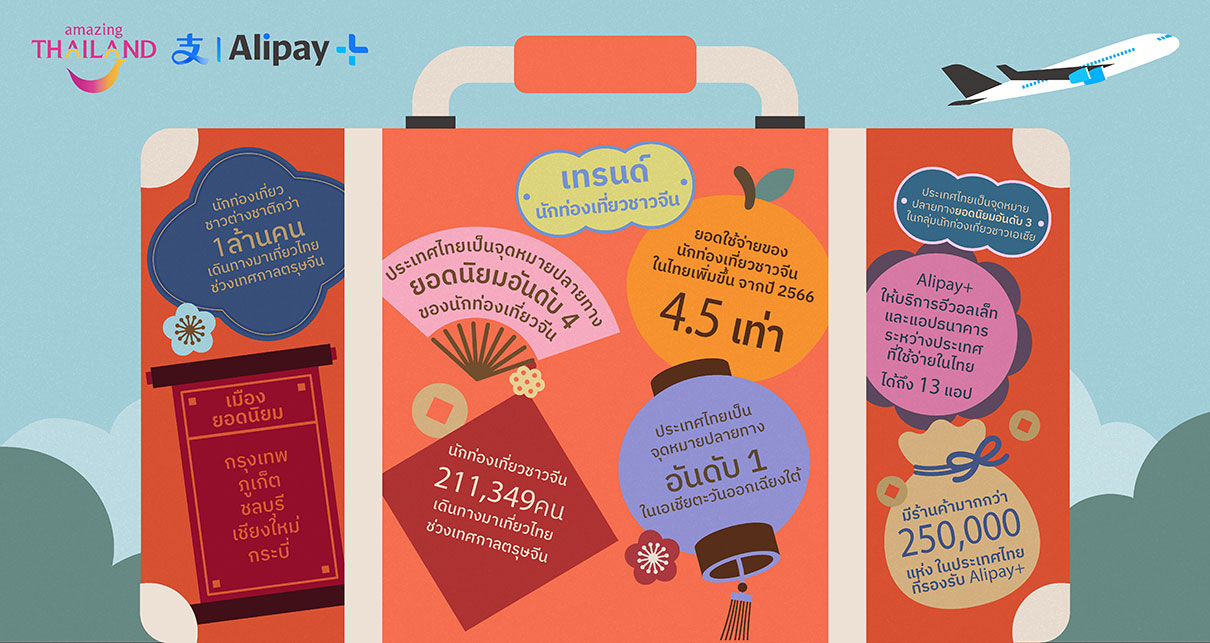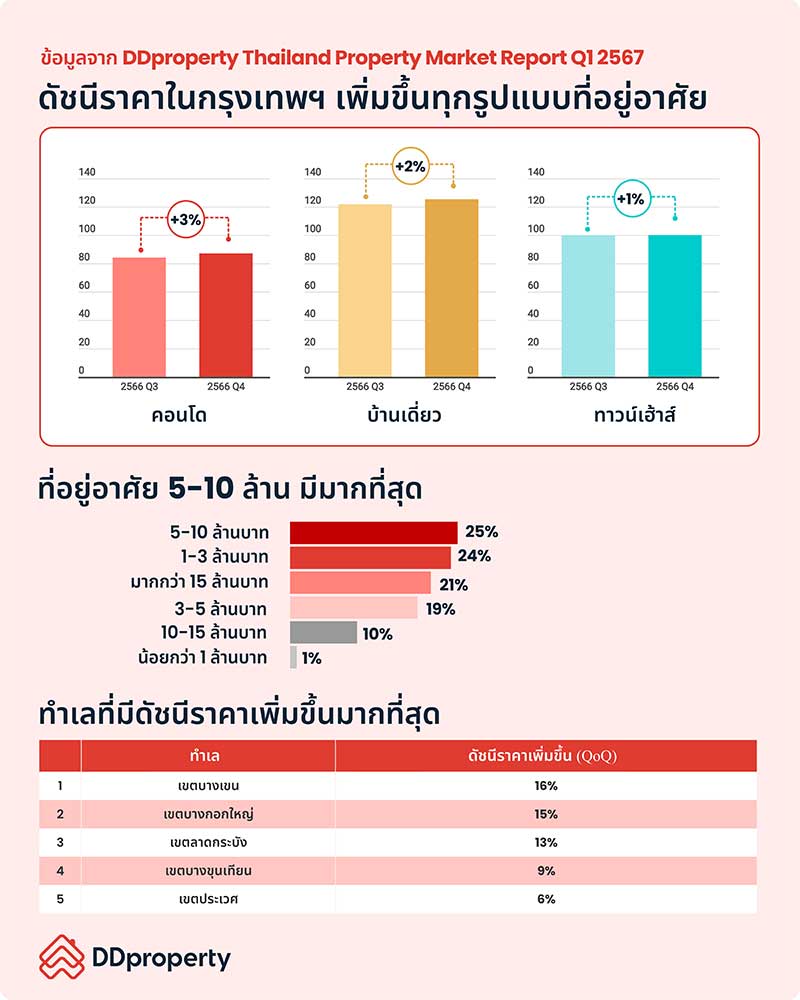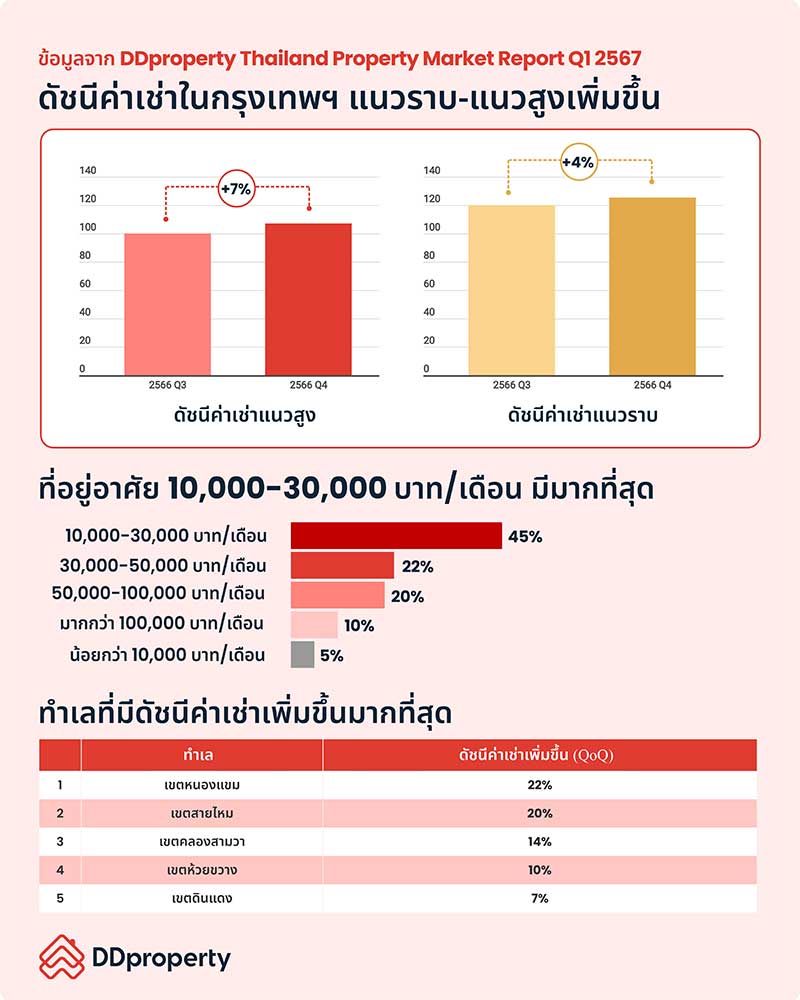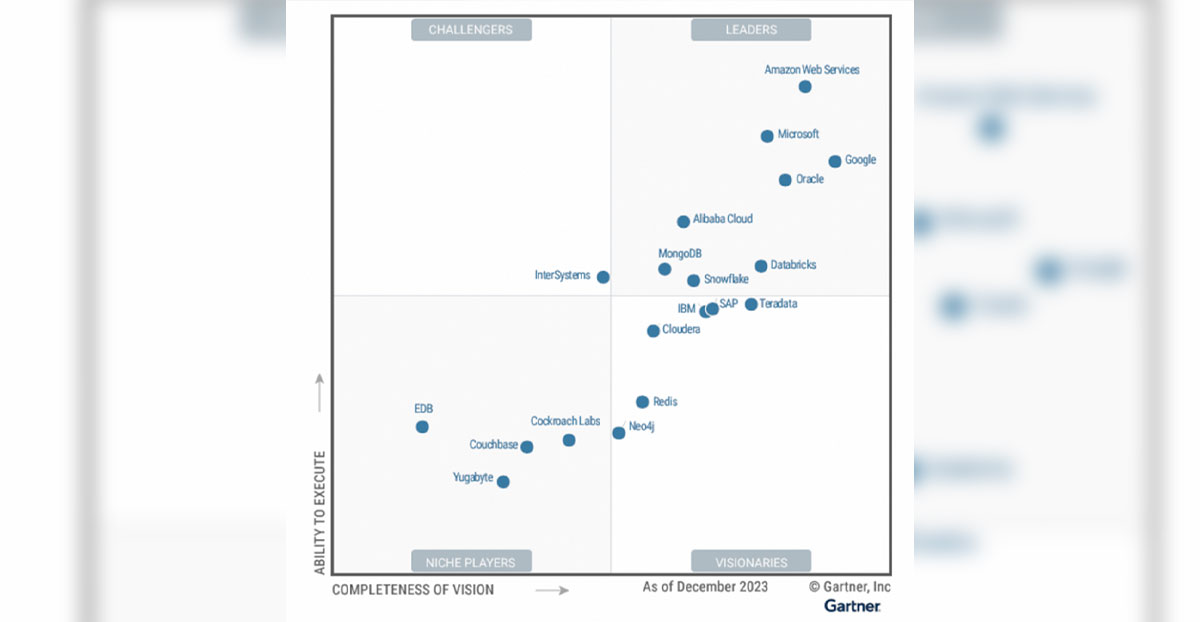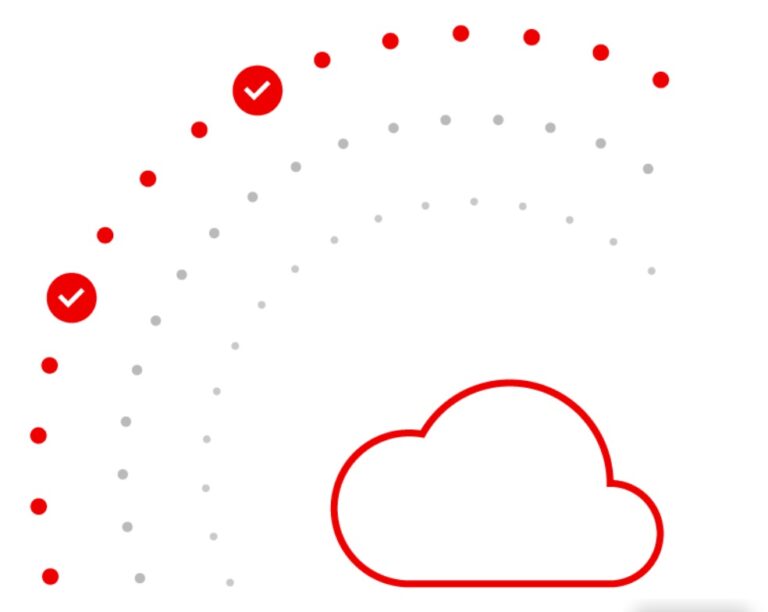การท่องเที่ยวแห่งประเทศไทย และ Alipay+ ร่วมกันต้อนรับนักท่องเที่ยวที่เพิ่มมากขึ้นในช่วงเทศกาลตรุษจีน
- ข้อมูลจาก ททท. เผยว่า มีนักท่องเที่ยวชาวต่างชาติเดิ
นทางเข้ามาเที่ยวประเทศไทยช่ วงเทศกาลตรุษจีนมากกว่า 1 ล้านคน โดยในจํานวนนี้เป็นนักท่องเที่ ยวชาวจีน 211,349 คน - จากข้อมูลของ ททท. พบว่าค่าใช้จ่ายโดยเฉลี่ยของนั
กท่องเที่ยวจีนเพิ่มขึ้น 15% จากปี 2562 ขณะที่ค่าใช้จ่ายของนักท่องเที่ ยวจากประเทศอื่นๆ ในเอเชียเพิ่มขึ้น 14% - จากข้อมูลของ Alipay+ ประเทศไทยเป็นจุ
ดหมายปลายทางยอดนิยมอันดับ 4 ของโลกของนักท่องเที่ยวจีน และเป็นอันดับ 3 ของนักท่องเที่ยวชาวเอเชีย โดยประเทศไทยเป็นจุ ดหมายปลายทางที่ได้รับความนิ ยมสูงสุดในภูมิภาคเอเชียตะวั นออกเฉียงใต้ของนักท่องเที่ ยวชาวจีน - Alipay+ เผยว่ายอดใช้จ่ายโดยรวมของนักท่
องเที่ยวชาวจีนในประเทศไทยเพิ่ มขึ้นกว่า 4.5 เท่าจากปี 2566 - Alipay+ ได้เปิดให้บริการอีวอลเล็ทระหว่
างประเทศ และแอปพลิเคชันธนาคารที่ สามารถใช้จ่ายในไทยได้ 13 รายการ โดยมีร้านค้าที่รองรับกว่า 250,000 แห่ง ทำให้ประสบการณ์การเดินทางราบรื่ นยิ่งขึ้น
ข้อมูลจากการท่องเที่ยวแห่งประเทศไทย (ททท.) และ Alipay+ แสดงให้เห็นถึงการฟื้นตัวที่แข็งแกร่งของการใช้จ่ายของผู้บริโภคในช่วงเทศกาลตรุษจีนที่กลับมาปกติเป็นครั้งแรกหลังการแพร่ระบาด โดยเฉพาะอย่างยิ่งในส่วนของการท่องเที่ยว cross-border ที่นักท่องเที่ยวชาวต่างชาติเดินทางเข้ามาท่องเที่ยวในประเทศไทย
ในช่วงเทศกาลตรุษจีน ข้อมูลจาก ททท. แสดงให้เห็นว่ามีนักท่องเที่ยวชาวต่างชาติเดินทางเข้ามาในประเทศไทยจํานวน 1,008,899 คน ซึ่งในจํานวนนี้เป็นนักท่องเที่ยวชาวจีน 211,349 คน ค่าใช้จ่ายโดยเฉลี่ยของนักท่องเที่ยวจีนเพิ่มขึ้น 15% จากปี 2019 ในขณะที่ค่าใช้จ่ายของนักท่องเที่ยวจากประเทศอื่นๆ ในเอเชียเพิ่มขึ้น 14% โดยหมวดหมู่ที่มีการใช้จ่ายสูงสุด ได้แก่ การช้อปปิ้ง, อาหารและเครื่องดื่ม, นวดและสปา, สถานที่ท่องเที่ยว และสถานบันเทิงยามค่ำคืน ส่วนเมืองท่องเที่ยวยอดนิยมในประเทศไทย ได้แก่ กรุงเทพฯ ภูเก็ต ชลบุรี เชียงใหม่ และกระบี่
นายฉัททันต์ กุญชร ณ อยุธยา, รองผู้ว่าการด้านตลาดเอเชียและแปซิฟิกใต้, การท่องเที่ยวแห่งประเทศไทย (ททท.) กล่าวว่า “จํานวนนักท่องเที่ยวที่เพิ่มขึ้นอย่างมากในช่วงเทศกาลตรุษจีนที่ผ่านมาสูงกว่าที่เราคาดการณ์ไว้ ซึ่งแสดงให้เห็นว่า ‘ประเทศไทย’ ยังคงเป็นหนึ่งในจุดหมายปลายทางการท่องเที่ยวยอดนิยมระดับโลก ในขณะที่เราเข้าสู่ปีใหม่พร้อมฤดูกาลท่องเที่ยวช่วงแรกของปี เป้าหมายของเราคือไม่เพียงแต่ดึงดูดนักท่องเที่ยวเข้ามาในประเทศไทยเท่านั้น แต่ยังรวมถึงการทําให้พวกเขาได้ท่องเที่ยวสะดวกสบายมากขึ้น ด้วยการทํางานร่วมกันอย่างใกล้ชิดกับพันธมิตรเช่น Alipay+ นอกจากเราจะสามารถดึงดูดนักท่องเที่ยวจากจีนและเอเชียได้มากขึ้นแล้ว เรายังสามารถช่วยให้นักท่องเที่ยวเหล่านี้มีประสบการณ์ดิจิทัลที่ดีขึ้น ซึ่งจะช่วยกระตุ้นการเติบโตให้กับธุรกิจท้องถิ่นของเรา ททท.มองหาโอกาสในการเสริมสร้างความร่วมมือกับ Alipay+ เพื่อผลักดันให้ประเทศไทยเป็นจุดหมายปลายทางยอดนิยมอันดับต้นๆ ของนักท่องเที่ยวทั่วโลกในปี 2567 และปีต่อๆไป”
ขยายอีโคซิสเต็มของ Alipay+ ในไทยเพื่อต้อนรับนักท่องเที่ยว
ภายใต้ความร่วมมืออย่างต่อเนื่อง ททท. และ Alipay+ ได้ร่วมกันเปิดตัวการตลาดแบบ co-marketing เพื่อดึงดูดนักท่องเที่ยวจากจีนและเอเชียให้เดินทางมายังประเทศไทย พร้อมทั้งมอบประสบการณ์การช้อปปิ้งและการเดินทางที่คุ้มค่ายิ่งขึ้นให้กับนักท่องเที่ยวเหล่านี้ รวมถึงการส่งเสริมความเชื่อมั่นและความปลอดภัย การโปรโมทแหล่งท่องเที่ยวหลัก เมืองสําคัญ และสถานที่ท่องเที่ยวต่างๆ ทั่วประเทศไทย ตลอดจนการแนะนําแคมเปญและโปรโมชั่นพิเศษสําหรับนักท่องเที่ยว
ในช่วงเทศกาลตรุษจีน 2567 ข้อมูลจาก Alipay+ ชี้ให้เห็นว่าประเทศไทยเป็นจุดหมายปลายทางระดับโลกที่ได้รับความนิยมสูงสุดเป็นอันดับ 4 จากนักท่องเที่ยวชาวจีน โดยมียอดใช้จ่ายเพิ่มขึ้น 4.5 เท่าเมื่อเทียบกับปี 2566 นอกจากนี้ประเทศไทยยังเป็นจุดหมายปลายทางอันดับ 1 ในเอเชียตะวันออกเฉียงใต้ของนักท่องเที่ยวจีน
ด้วยการสนับสนุนของ Alipay+ อีวอลเล็ทระหว่างประเทศ และแอปพลิเคชั่นธนาคาร 13 รายการสามารถใช้งานในประเทศไทยได้แล้ว โดย 9 รายเป็นผู้ให้บริการรายใหม่ ได้แก่ MyPB ของ Public Bank Berhad (มาเลเซีย), Naver Pay และ Toss Pay (เกาหลีใต้), Changi Pay และ OCBC Digital (สิงคโปร์), GCash (ฟิลิปปินส์), Hipay (มองโกเลีย), MPay (เขตบริหารพิเศษมาเก๊าของจีน) และ Tinaba (อิตาลี)
Alipay (จีนแผ่นดินใหญ่) รองรับการใช้จ่ายในประเทศไทยตั้งแต่ปี 2558 ขณะที่ AlipayHK (เขตบริหารพิเศษฮ่องกงของจีน), Kakao Pay (เกาหลีใต้) และ Touch ‘n Go eWallet (มาเลเซีย) รองรับการใช้จ่ายในประเทศไทยตั้งแต่ปี 2566
ประเทศไทยยังเป็นจุดหมายปลายทางระดับโลกยอดนิยมอันดับ 3 ในกลุ่มนักท่องเที่ยวชาวเอเชีย และการเพิ่มจำนวนอีวอลเล็ทเหล่านี้ก่อนฤดูกาลท่องเที่ยวได้ช่วยเพิ่มความสะดวกสบายให้กับนักท่องเที่ยว พร้อมทั้งสร้างโอกาสเติบโตให้กับธุรกิจท้องถิ่นด้วย
Alipay+ ยังคงขยายการรองรับจํานวนร้านค้าอย่างต่อเนื่อง โดยปัจจุบันมีการให้บริการในร้านค้ามากกว่า 250,000 แห่งในประเทศไทย นอกเหนือจากร้านค้าปลีกและ F&B แล้ว ยังมีร้านค้าใหม่อื่นๆ ที่ครอบคลุมรูปแบบการใช้จ่ายที่หลากหลายของนักท่องเที่ยว เช่น ร้านสะดวกซื้อเซเว่นอีเลฟเว่น ห้างบิ๊กซี สถานที่ท่องเที่ยวเช่น พระบรมมหาราชวัง ร้านขายของที่ระลึก และสถานบริการสุขภาพและสปา เช่น Let’s Relax และ Health Land
ประเทศไทยยังคงเป็นจุดหมายปลายทางด้านการชอปปิ้งที่สําคัญสําหรับนักท่องเที่ยว โดยร้านค้ายอดนิยมรวมถึง คิงเพาเวอร์ ห้างสรรพสินค้าในเครือสยามพิวรรธน์ และ ห้างเครือเซ็นทรัล นอกจากนี้ การขยายตัวของร้านค้าพันธมิตร Alipay+ ในประเทศไทยล่าสุด ยังทําให้การเดินทางในชีวิตประจําวันสะดวกสบายยิ่งขึ้นด้วยร้านสะดวกซื้อ 7-Eleven และ Big C Supermarket ซึ่งเป็นหนึ่งในร้านค้ายอดนิยมด้วยเช่นกัน
นายสิทธิพงษ์ กิตติประภาพงศ์, ผู้จัดการทั่วไปฝ่าย Global Merchant Partnership ประจำประเทศไทย, Ant International กล่าวว่า “ความร่วมมือใกล้ชิดอย่างต่อเนื่องของเรากับ ททท. ช่วยดึงดูดนักท่องเที่ยวจากจีนและเอเชียให้เดินทางเข้ามาในประเทศไทยมากขึ้น พร้อมทั้งมอบความสะดวกสบายให้แก่นักท่องเที่ยวในการจับจ่ายใช้สอยซื้อสินค้าได้ทั่วประเทศ ปัจจุบันประสบการณ์ดิจิทัลแบบไร้รอยต่อถือเป็นเรื่องธรรมดาสําหรับนักท่องเที่ยว และด้วยการรองรับแอปชําระเงินที่เป็นพันธมิตร Alipay+ ที่มากขึ้นในประเทศไทย ส่งผลให้การทำธุรกรรมโดยใช้อีวอลเล็ทในประเทศของนักท่องเที่ยวมีจำนวนเพิ่มสูงขึ้น เป้าหมายของเราคือการขยายเครือข่ายร้านค้าที่รองรับ Alipay+ เพื่อให้ธุรกิจท้องถิ่นได้รับประโยชน์จากการเติบโตของอุตสาหกรรมการท่องเที่ยวในปีต่อๆไป เรามองหาโอกาสที่จะเสริมสร้างความร่วมมือกับ ททท. และร้านค้าในท้องถิ่นอย่างจริงจัง ทั้งในเรื่องของการให้ความรู้ การโปรโมทร้านค้า และการรับชําระเงินระหว่างประเทศ”
การฟื้นตัวอย่างแข็งแกร่ง จุดหมายปลายทางที่หลากหลาย และสถานการณ์การเดินทางท่องเที่ยวของนักท่องเที่ยวจากจีนที่ใช้ Alipay
ด้วยโซลูชันเทคโนโลยีการชําระเงินข้ามพรมแดนบนมือถือของ Alipay+ นักท่องเที่ยวชาวจีนสามารถจ่ายค่าสินค้า อาหารและเครื่องดื่ม การพักผ่อนหย่อนใจ และความบันเทิง ที่ร้านค้ามากกว่า 8 ล้านแห่งในกว่า 70 ประเทศและภูมิภาคทั่วโลกด้วยการใช้แอป Alipay ที่คุ้นเคย โดยไม่ต้องแลกเงิน หรือพกเงินสด Alipay ยังมีบริการคืนภาษีทันทีภายในแอป ตลอดจนอัตราแลกเปลี่ยนเงินที่โปร่งใสและแข่งขันได้
ประเทศไทย เขตบริหารพิเศษฮ่องกง ญี่ปุ่น มาเก๊า มาเลเซีย สิงคโปร์ เกาหลีใต้ ฝรั่งเศส ออสเตรเลีย และแคนาดา เป็น 10 อันดับแรกของจุดหมายปลายทางที่นักท่องเที่ยวจีนใช้จ่ายผ่าน Alipay มากที่สุด โดย ไทย มาเลเซีย และสิงคโปร์ มียอดใช้จ่ายรวมกันเพิ่มขึ้น 7.5% เมื่อเทียบกับปี 2562 และเพิ่มขึ้นถึง 580% เมื่อเทียบกับปี 2566 ซึ่งประเทศไทยเป็นผู้นําด้านปริมาณการใช้จ่ายโดยรวมสูงที่สุด ในขณะที่มาเลเซียมีอัตราการเติบโตสูงที่สุด
ความสัมพันธ์ทางเศรษฐกิจและสังคมอันใกล้ชิดระหว่างเขตบริหารพิเศษฮ่องกง มาเก๊า และจีนแผ่นดินใหญ่ นโยบายยกเว้นวีซ่าในประเทศหลักในเอเชียตะวันออกเฉียงใต้ เช่น ประเทศไทย และการฟื้นตัวของเที่ยวบินระหว่างประเทศ เป็นปัจจัยสําคัญในการขับเคลื่อนการเติบโตของการท่องเที่ยวข้ามพรมแดน ขณะที่แหล่งท่องเที่ยวยอดนิยมในเอเชียยังคงได้รับความสนใจอย่างต่อเนื่อง จุดหมายปลายทางที่อยู่ไกลออกไปในยุโรป, ออสเตรเลียและนิวซีแลนด์ (ANZ), ตะวันออกกลาง และอเมริกาเหนือ ก็เริ่มได้รับความนิยมในหมู่นักท่องเที่ยวจีนเช่นกัน
แคมเปญระดับโลกดำเนินไปอย่างเต็มรูปแบบผ่านเครือข่ายผู้ค้า Alipay+ ตั้งแต่เดือนธันวาคม 2566 เพื่อดึงดูดนักท่องเที่ยวชาวจีน ในช่วงวันหยุดเทศกาลตรุษจีน ระหว่างวันที่ 9 ถึง 12 กุมภาพันธ์ จำนวนธุรกรรมที่ทำโดยผู้ใช้ Alipay ในต่างประเทศ แซงหน้าปี 2562 ถึง 7% ขณะที่ยอดใช้จ่ายของผู้บริโภคฟื้นตัวกลับมาอยู่ที่ 82% ของยอดใช้จ่ายในปี 2562 หรือเพิ่มขึ้นถึง 2.4 เท่าเมื่อเทียบกับปี 2566
นอกจากการเดินทางที่ขยายขอบเขตมากขึ้น นักท่องเที่ยวจีนยังขยายความสนใจจากกิจกรรมเดิมๆ เช่น การช้อปปิ้งและเยี่ยมชมแหล่งท่องเที่ยวหลักๆ ไปสู่ประสบการณ์ท้องถิ่นที่มีส่วนร่วมและมีเอกลักษณ์มากขึ้น ในสัปดาห์วันหยุดตรุษจีนทั่วโลก นักท่องเที่ยวจีนใช้จ่ายไปกับอาหารและเครื่องดื่มมากกว่าปี 2562 ถึง 70% โดยขยายจากจุดหมายยอดนิยมในเมืองไปสู่สถานที่ท้องถิ่นที่น่าสนใจ
การส่งเสริมการท่องเที่ยวต่างประเทศผ่านอีวอลเล็ทพันธมิตรของ Alipay+ และแอปพลิเคชันธนาคาร
เทศกาลตรุษจีนเป็นที่รู้จักอย่างแพร่หลายในคอมมูนิตี้ชาวเอเชีย ด้วยความร่วมมือใหม่ในปี 2566 และจำนวนการเดินทางที่เพิ่มขึ้น การใช้จ่ายข้ามพรมแดนโดยรวมบนอีวอลเล็ทชั้นนําของประเทศต่างๆ ที่ได้รับการสนับสนุนจาก Alipay+ เพิ่มขึ้นถึง 252% จากปีก่อน ธุรกรรมเฉลี่ยต่อวันเพิ่มขึ้น 304% โดยประเทศไทย ญี่ปุ่น เกาหลีใต้ มาเก๊า และสิงคโปร์ เป็น 5 อันดับแรกของจุดหมายปลายทางยอดนิยมของผู้ใช้งาน Alipay+ นอกเหนือจากนักท่องเที่ยวจากจีนแผ่นดินใหญ่
ในจีนแผ่นดินใหญ่ บัญชี Alipay ที่เชื่อมกับอีวอลเล็ทและบัตรต่างประเทศเติบโตอย่างก้าวกระโดด ช่วงเทศกาลตรุษจีน 2567 นักท่องเที่ยวต่างชาติในจีนใช้จ่ายผ่านบัญชี Alipay ที่เชื่อมโยงกับบัตรต่างประเทศที่ร้านค้าในจีนมากขึ้นถึง 500% เมื่อเทียบกับปี 2566 ร้านอาหารจีน สถานที่ท่องเที่ยว และระบบขนส่งมวลชน เป็นแหล่งที่มีการใช้งานสูงสุดในหมู่นักท่องเที่ยวต่างชาติที่เดินทางมายังประเทศจีนและร่วมงานเทศกาล ตั้งแต่เดือนกันยายน 2566 Alipay+ รองรับอีวอลเล็ทและแอปการชําระเงินชั้นนํา 10 รายในเอเชีย รวมถึง TrueMoney เพื่ออำนวยความสะดวกนักท่องเที่ยวต่างชาติด้วยบริการจากผู้ค้าในเครือข่าย Alipay กว่า 80 ล้านแห่งทั่วประเทศจีน โดย Visa, Mastercard, JCB, Discover®, และ Diners Club International® ยังขยายความร่วมมือกับ Alipay สําหรับนักท่องเที่ยวที่เชื่อมต่อบัตรเครดิตหรือบัตรเดบิตระหว่างประเทศของพวกเขากับกระเป๋าเงินอิเล็กทรอนิกส์ Alipay


